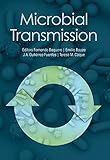Microbial transmission / editors, Fernando Baquero, Emilio Bouza, J.A. Gutiérrez-Fuentes, Teresa M. Coque.
Material type: TextPublisher: Washington, DC : ASM Press, [2019]Copyright date: ©2019Description: 1 online resource : illustrationsContent type:
TextPublisher: Washington, DC : ASM Press, [2019]Copyright date: ©2019Description: 1 online resource : illustrationsContent type: - text
- computer
- online resource
- 9781555819743
- 1555819745
- 9781523123926
- 1523123923
- 9781683670490
- 1683670493
- Communicable diseases -- Transmission
- Infection
- Pathogenic bacteria
- Disease Transmission, Infectious
- Communicable Diseases -- microbiology
- Infections -- microbiology
- Microbiological Phenomena
- HEALTH & FITNESS -- Diseases -- General
- MEDICAL -- Clinical Medicine
- MEDICAL -- Diseases
- MEDICAL -- Evidence-Based Medicine
- MEDICAL -- Internal Medicine
- Communicable diseases -- Transmission
- Infection
- Pathogenic bacteria
- 616.9/0471 23
- RB153
- 2019 D-448
- QW 700
Print version record.
Includes bibliographical references and index.
Intro; Half Title; Title Page; Copyright; Contents; Contributors; Preface: Transmission and Interaction; About the Editors; INTRODUCTION; Chapter 1: Origin, History, and Meanings of the Word Transmission; ORIGIN AND MEANING OF MITTERE; ORIGIN AND MEANING OF TRANS-; DERIVATIVES OF THE VERB MITTERE; CITATION; REFERENCES; BASIC PROCESS OF TRANSMISSION; Chapter 2: Causality in Biological Transmission: Forces and Energies; THE COGNITIVE REPRESENTATION OF THE CONCEPT OF TRANSMISSION; COMPONENTS OF THE TRANSMISSION PROCESS; BIOLOGICAL ENTITIES AS MESSAGES
CAUSALITY OF TRANSMISSION: FORCES AND ENERGIES; THE CAUSAL QUESTIONS IN TRANSMISSION; THE ULTIMATE CAUSE OF TRANSMISSION; THE PROXIMATE CAUSES OF TRANSMISSION; PROXIMATE CAUSES OF EMISSION; Causes Originated by the Size, Quality, and Location of the Emitter Patch; Patch size limitation; Local demographics: Overpopulated patch; Breeding requirements; Progeny crowding; Nutrient shortage; Unfit patch conditions; Distance between emitter and receiver patches: Mosaics and gradients; Causes Originated in Populations' Conflicts within the Emitter Patch; Local negative interactions
Cooperation for transmission; Patch deconstruction; Displacement from the patch; Causes Related to the Lifestyle of Biological Individuals; Search for optimal or exclusive patches; Search for patches enabling genetic diversification and evolution; Vagility: Explorer life plan strategy; THE PROXIMATE CAUSES OF INTEGRATION AND PERMANENCE IN THE PATCH; Causes Originated by the Size, Quality, and Location of the Hosting Patch; Stability and sustainability; Shielded environments; Specific and rare hosting patches; Host patches with predictable fluctuation; Niche construction
Causes Originated in Interactions within the Host Patch; Stable or cooperative interactions with local biological entities; Patch allowing low-cost replication; Causes Related to Biological Individuals; Exploiter life plan strategy; VEHICLES AS CAUSES OF TRANSMISSION; TRANSMISSION AND THE CAUSES OF NATURAL SELECTION: CIS- AND TRANS-EVOLUTION; CODA: CAUSES AND EFFECTS; ACKNOWLEDGMENTS; CITATION; REFERENCES; Chapter 3: Natural and Artificial Strategies to Control the Conjugative Transmission of Plasmids; INTRODUCTION; HORIZONTAL GENE TRANSFER; BACTERIAL CONJUGATION
Conjugative Transfer, the Process; NATURAL STRATEGIES THAT CONTROL CONJUGATION; Host Strategies: Restriction; Host Strategies: CRISPR-Cas; Other Host Factors Involved in the Control of Conjugation; Plasmid Strategies: Exclusion; Plasmid Strategies: Fertility Inhibition; Transfer Inhibition of IncF Plasmids; Transfer Inhibition of IncW Plasmids; Transfer Inhibition of IncP Plasmids; Transfer Inhibition of pTi Plasmid's T-DNA; ARTIFICIAL STRATEGIES TO CONTROL CONJUGATION; Relaxase Inhibitors; Pilus Blockers; Nonspecific COINs; Unsaturated Fatty Acids
T4SS Inhibitors Discovered by Biochemical Analysis
Microbial transmission, the processes by which microbes transit to new environments, is a significant and broad-reaching concept with applications throughout the biological sciences. This collection of reviews, edited by an international team of experts studying and working across a range of disciplines, explores transmission not just as an idea in disease but as a fundamental biological process that acts in all domains of nature and exerts its force on disparate size scales, from the micro to the macro, and across units of time as divergent as a single bacterial replication cycle and the entire course of evolution. In five sections, this overview --Defines the concept of transmission and covers basic processes of transmission, including causality, control strategies, fitness costs, virulence, and selection--Presents numerous combinations of transmission scenarios across the bacterial, animal, and human interface --Examines transmission as the defining characteristic of infectious disease--Presents methods for experimentally verifying and quantifying transmission episodes--Concludes with important theoretical and modeling approaches. Anyone studying or working in microbial colonization, evolution, pathogenicity, antimicrobial resistance, or public health will benefit from a deeper understanding of Microbial Transmission.
There are no comments on this title.
